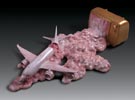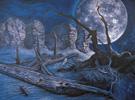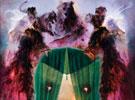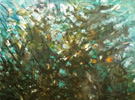The suspension of disbelief
Installation Art is a form of diversion that intensifies the senses of the viewers through induced spatial and physical consciousness. This journey is plugged with a specific context that serves its very nature and reason to exist.
The viewer is frequently positioned on some level of ambiguity, experiencing disturbance as an art practice. To direct and redirect the attention and positions of the viewer on site inspires a metaphor of uncertainty. A metaphor that does not clarify what installation art is.
On James Chu Installations the audience is usually invited to wander around an altered space where a peripheral vision is requested. A foresight of the elements that constitute the work is absolutely essential to experience its full extent. This sagacity, this need of being in, exploring, interpreting, envisaging and living the moment encourages the viewer to feel as a participant, as an active element.
In “Washing Legs in Macau” (2010) a white minimal parallelepiped capsule hides a real size sculpture of a pair of legs with the feet on a basin full of water. This image is only possible to catch individually looking through a micro hole where a micro magnifying lens unveils the interior. The work is completed with the recording of two voices overlapping one another in Cantonese and Portuguese creating a mumbled sound effect.
The peeping tom upshot of Marcel Duchamp’s “Etant Donnés” (1946-1966) and the use of the spectator within the artwork of Bruce Nauman’s “Performance Corridor” (1969) are examples of an astonishing legacy. A whispered inheritance for an art practice that relentlessly invites the viewer for direct participation. The fact is that for this settlement to be meaningful the work requires an active viewer. This knowledge gives us another magnitude of what Installation Art is and what it can be.
“Washing Legs in Macau” situates us on a contemporary interpretation of this heritage at the same time that is iconic of the city and time that represents. Overall the work encourages to search richer multiple meanings in a state of controlled uncertainty. As for Lewis Carroll’s Alice the viewer needs to look ‘through the looking glass’ and, if possible, fall down the ‘rabbit hole.’
A good artwork is a leap of faith and most times is out of the control of the artist. The sublime moment of recognizing it is the one of the few objective evidences of the phenomenon of experiencing art itself.
“Introduce 366 days” is a video installation that is the result of a series of actions created by a somehow hypothetical detective, a reporter of contradictions, of enigmatic encounters. Situated between the poetic and the social the documents are immersed in authenticity. This investigator - the artist himself - reflects on the absurd of existence, considering mundane events and correlating them in alternative perspectives.
Beyond the surface, beyond the appearance of everyday reality, this searcher explores the life of Shanghai through the eyes of the 24 hours working taxi drivers. The eyes are the windows of the soul but somehow this work exists as a negation or a contradiction of that other illusion. What suddenly changes the context, what exists after the poetic and social documents is indicated intentionally by the use of different views of the same scene. It raises the complexity of what the artwork is and what it includes and this striking proposition is boosted and balanced between the different cameras, the driver, the author, the cars and the city making all these elements, in that exact moment, a leap of faith left deliberately out of control by the artist.
For James Chu, art and social affairs are not separate entities. His consequent double life leads him back and forth between the roles of artist and broadminded society participant. Not only does he produce artwork, he’s also involved, most of the times as a volunteer, in social activities and art events organization.
His bright voice has a unique impact in the wilderness of the last decade of the Macau art scene both as an artist and cultural key figure. His artwork usually inspires puzzled admiration from the audience, merging styles and media within installations of unsettling complexity.
“Five-storey Mansions” (2011) have this powerful and dynamic force exploring the physical and mental space of the community at the same time that is one of the most contemplative works of the artist. Elected to represent Macau in Venice 2011 it’s a work that involves a great deal of meanings, pointing to considerations of life and exploring feelings of memory and everyday experiences.
Images are combined on rotating glasses, with lights and projected shadows contributing for a spectacular although peaceful effect. The reflective and meditative moment is stimulated by the musical encounter with local composer Lei Vai Fan.
This installation is a highlight of the singularity of the artwork as a proof of history and a testimony of existence, in a manner that is itself charming, proposing that one stage of art is to speculate on what it means, what it challenges when is converted in a spiritual object.
The interactivity of this piece operates fully on the mind, which is the home where the collapse between the symbolic and the real exists. One is called to search on his depths of perception for the mysterious shadows of time since the insights provided by the photographic narrative are, once again, suspended in disbelief.




